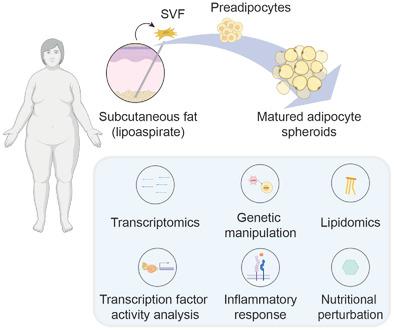Our official English website, www.x-mol.net, welcomes your
feedback! (Note: you will need to create a separate account there.)
3D Adipose Tissue Culture Links the Organotypic Microenvironment to Improved Adipogenesis
Advanced Science ( IF 14.3 ) Pub Date : 2021-06-24 , DOI: 10.1002/advs.202100106 Joanne X Shen 1 , Morgane Couchet 2 , Jérémy Dufau 3, 4 , Thais de Castro Barbosa 2 , Maximilian H Ulbrich 5, 6 , Martin Helmstädter 5 , Aurino M Kemas 1 , Reza Zandi Shafagh 1, 7 , Marie-Adeline Marques 3, 4 , Jacob B Hansen 8 , Niklas Mejhert 2 , Dominique Langin 3, 4, 9 , Mikael Rydén 2 , Volker M Lauschke 1
Advanced Science ( IF 14.3 ) Pub Date : 2021-06-24 , DOI: 10.1002/advs.202100106 Joanne X Shen 1 , Morgane Couchet 2 , Jérémy Dufau 3, 4 , Thais de Castro Barbosa 2 , Maximilian H Ulbrich 5, 6 , Martin Helmstädter 5 , Aurino M Kemas 1 , Reza Zandi Shafagh 1, 7 , Marie-Adeline Marques 3, 4 , Jacob B Hansen 8 , Niklas Mejhert 2 , Dominique Langin 3, 4, 9 , Mikael Rydén 2 , Volker M Lauschke 1
Affiliation

|
Obesity and type 2 diabetes are strongly associated with adipose tissue dysfunction and impaired adipogenesis. Understanding the molecular underpinnings that control adipogenesis is thus of fundamental importance for the development of novel therapeutics against metabolic disorders. However, translational approaches are hampered as current models do not accurately recapitulate adipogenesis. Here, a scaffold-free versatile 3D adipocyte culture platform with chemically defined conditions is presented in which primary human preadipocytes accurately recapitulate adipogenesis. Following differentiation, multi-omics profiling and functional tests demonstrate that 3D adipocyte cultures feature mature molecular and cellular phenotypes similar to freshly isolated mature adipocytes. Spheroids exhibit physiologically relevant gene expression signatures with 4704 differentially expressed genes compared to conventional 2D cultures (false discovery rate < 0.05), including the concerted expression of factors shaping the adipogenic niche. Furthermore, lipid profiles of >1000 lipid species closely resemble patterns of the corresponding isogenic mature adipocytes in vivo (R2 = 0.97). Integration of multi-omics signatures with analyses of the activity profiles of 503 transcription factors using global promoter motif inference reveals a complex signaling network, involving YAP, Hedgehog, and TGFβ signaling, that links the organotypic microenvironment in 3D culture to the activation and reinforcement of PPARγ and CEBP activity resulting in improved adipogenesis.
中文翻译:

3D 脂肪组织培养将器官微环境与改善脂肪生成联系起来
肥胖和 2 型糖尿病与脂肪组织功能障碍和脂肪生成受损密切相关。因此,了解控制脂肪生成的分子基础对于开发针对代谢紊乱的新疗法至关重要。然而,由于当前模型不能准确地概括脂肪生成,转化方法受到阻碍。在这里,提出了一种具有化学限定条件的无支架多功能 3D 脂肪细胞培养平台,其中原代人类前脂肪细胞准确地再现了脂肪生成。分化后,多组学分析和功能测试表明,3D 脂肪细胞培养物具有与新鲜分离的成熟脂肪细胞相似的成熟分子和细胞表型。与传统 2D 培养物相比,球状体表现出生理相关的基因表达特征,有 4704 个差异表达基因(错误发现率 < 0.05),包括塑造脂肪形成生态位的因子的协同表达。此外,超过 1000 种脂质种类的脂质谱与体内相应同基因成熟脂肪细胞的模式非常相似 ( R 2 = 0.97)。使用全局启动子基序推断将多组学特征与 503 个转录因子的活性谱分析相结合,揭示了一个复杂的信号网络,涉及 YAP、Hedgehog 和 TGF β 信号,将 3D 培养中的器官型微环境与激活和强化联系起来PPAR γ和 CEBP 活性导致脂肪生成改善。
更新日期:2021-08-19
中文翻译:

3D 脂肪组织培养将器官微环境与改善脂肪生成联系起来
肥胖和 2 型糖尿病与脂肪组织功能障碍和脂肪生成受损密切相关。因此,了解控制脂肪生成的分子基础对于开发针对代谢紊乱的新疗法至关重要。然而,由于当前模型不能准确地概括脂肪生成,转化方法受到阻碍。在这里,提出了一种具有化学限定条件的无支架多功能 3D 脂肪细胞培养平台,其中原代人类前脂肪细胞准确地再现了脂肪生成。分化后,多组学分析和功能测试表明,3D 脂肪细胞培养物具有与新鲜分离的成熟脂肪细胞相似的成熟分子和细胞表型。与传统 2D 培养物相比,球状体表现出生理相关的基因表达特征,有 4704 个差异表达基因(错误发现率 < 0.05),包括塑造脂肪形成生态位的因子的协同表达。此外,超过 1000 种脂质种类的脂质谱与体内相应同基因成熟脂肪细胞的模式非常相似 ( R 2 = 0.97)。使用全局启动子基序推断将多组学特征与 503 个转录因子的活性谱分析相结合,揭示了一个复杂的信号网络,涉及 YAP、Hedgehog 和 TGF β 信号,将 3D 培养中的器官型微环境与激活和强化联系起来PPAR γ和 CEBP 活性导致脂肪生成改善。











































 京公网安备 11010802027423号
京公网安备 11010802027423号